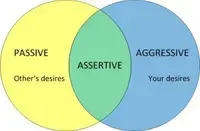Assertiveness: The Goldilocks of Communication

Assertiveness is the quality of expressing your views, opinions or feelings, in a calm and clear manner, without becoming either verbally aggressive or too passive. It’s a fine balance to strike, and we don’t always get it right.
Let’s have a look into the 3 most common styles of communication that people generally use. I’m going to label these as the passive, the assertive and the aggressive. Please bear in mind that people might use a combination of these styles and that these are not mutually exclusive. However, individuals are likely to have a main communication style and this will have an impact on their relationships with others, and with themselves.
Passive
Individuals with a passive communication style tend to think that their needs are not really important and have a tendency to prioritise others above themselves. This is reflected in their tendency to be compliant, submissive, or putting themselves down in prole of praising others. They have difficulty in expressing what they think and in saying “no”, and they end up talking little or not saying anything, even if they don’t agree with or are unhappy about something. Their body language might include stooping, hunched shoulders, and avoiding eye contact. Let’s look at some examples of passive communication:
- “I don’t mind, that’s absolutely fine” (when it’s not fine)
- “You’re right, I’m so stupid”
- “I’m so sorry about it, it’s totally my fault” (when it was not)
Aggressive
Individuals with an aggressive communication style think that their needs are more important than other peoples’ needs, and therefore they tend to talk over others. They may come across as sarcastic, harsh, over-critical, patronising, and have a “know it all” attitude. They may be disrespectful, bully others, shout or become verbally aggressive. Their body language might include pointing fingers or making oneself look “big”. Let’s look at some examples of aggressive communication:
- “This is what I want to do, if you don’t like it, that’s your problem”
- “You’re being really stupid, you know”
- “F….off”
Assertive
Individuals with an assertive communication style recognise their own needs as well as other people’s needs. They are firm but polite, and are respectful of oneself and others. They tend to express their views clearly and confidently, and they tend to have a relaxed and open posture. Let’s look at some examples of assertive communication:
-
“That’s a really good idea, but I’d also like to do…”
-
“I can see that, but how about if we try that instead. Would it be ok?”
-
“I’d like a refund, please.”
What consequences can these communication styles have on oneself and others?
Because individuals with a passive communication style tend to consistently give in to others, this can have a damaging effect on their self-confidence and self-esteem. In the long-term, this can build resentment, and can lead to feelings of unfulfillment, stress and low mood (as one’s needs are not being met). Having a passive communication style can also affect relationships with others, as others are less likely to respect you.
In contrast, individuals with an aggressive communication style can easily make enemies and upset others, which can damage relationships, as other people don’t like to feel attacked or insulted. Typical negative effects of an aggressive communication style are arguments with partners, lack of deep friendships, and ultimately feelings of loneliness.
Oftentimes, individuals alternate between a passive and an aggressive communication style (so called passive-aggressive). This is because someone with a passive communication style tends to bottle things up and, one day, eventually behaves aggressively. It’s a bit like a pressure cooker where the steam slowly builds up and eventually the water comes off the pan.
In comparison with the passive and the aggressive styles of communication, which can damage relationships, an assertive communication style is more conducive to good relationships with others, as individuals are more willing to compromise and others know where they stand. Having an assertive communication style also builds self-confidence, as individuals stand up for themselves, but in a fair way, so others respect them.
What about you, what is your predominant communication style? What effect has it had on your relationships with other people? Most importantly, what effect has it had on your relationship with yourself?
